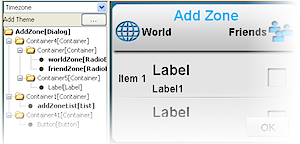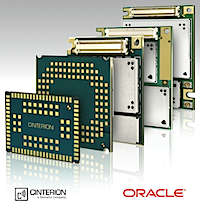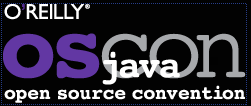You are currently browsing the monthly archive for August 2011.
Monthly Archive
Small, smart, connected: Cinterion Java-powered Wireless Modules
08/16/2011 in Mobile & Embedded | Tags: CINTERION, Duke's Choice, embedded, Embedded Java, Java ME, M2M, mHealth, Wireless Module | Leave a comment
You need a small, wireless compute platform to embed into your smart devices? Powered by Java – making it secure, robust, and easy to program?
Cinterion, based in Germany, has been shipping Java-powered wireless modules since 2003 into key M2M (machine-to-machine) markets such as mHealth, even winning a Duke’s Choice Award in 2010 for its innovative technologies.
These modules are amazing little compute platforms, complete with a CLDC/IMP Java runtime, IP-based cellular data connectivity, various I/O, and even GPS and other options. Software development is easy – use Eclipse or NetBeans, apply your existing Java skills, and you’ll be developing applications in no time.
In the latest Cinterion-Oracle customer success story, the Philips Respironics System One sleep therapy platform uses the Cinterion TC65i Java module and the GSM/GPRS network to allow doctors to remotely analyze patients breathing data and make changes to the air pressure administered by the device.
To learn more about Cinterion and other embedded Java technologies and solutions, register for the Embedded Java Resource Kit, which includes the following material and information:
- On Demand Webcast: Learn How Java Can Power Devices and Infrastructures For The Smart Grid
- White Paper: Making the Smart Grid Smarter With Embedded Java
- Customer Success Story: Cinterion and Oracle
- Embedded Java and Healthcare: Learn How Java Can Power Medical Devices and Healthcare Systems
- Data Sheets
-
- Java ME Embedded Client Datasheet
- Java SE Embedded Datasheet
- Oracle Java Wireless Client 3.0 Datasheet
Cheers,
— Terrence
Java 7 Q&A and ‘A Bugs Life’
08/12/2011 in Mobile & Embedded | Tags: Bugs, Henrik Stahl, Java, Java 7, Java SE 7, JDK 7, Q & A | Leave a comment

These two posts hit the airwaves just recently, wanted to make sure you are aware of them:
- Henrik Ståhl: Java 7 Questions & Answers
- Dalibor Topic: A Bugs Life
Cheers,
— Terrence
LWUIT 1.5 released!
08/12/2011 in Mobile & Embedded | Tags: Beyond Smartphones, LWUIT | Leave a comment

Version 1.5 of the Lightweight UI Toolkit (LWUIT) is out!
This is the culmination of more than a year of diligent work by the LWUIT team and valuable input and feedback from the LWUIT developer community.
The result is a major revamp of the GUI Builder, and a significantly improved LWUIT toolkit with new functionality, changes, and enhancements to in many areas:
- GUI Builder with major revamp of the Resource Editor tool
- LWUIT4IO a tightly integrated Storage, Networking & Filesystem framework with ports to multiple platforms
- Far deeper theming including, theme constants, declarative style inheritance, disabled styles etc.
- New JavaSE & CDC ports allowing easier debugging/testing/profiling on the desktop as well as easier demos by deploying LWUIT applications as applets
- New Components:
- ContainerList allows variable row size list & complex list layouts
- Tabs supersedes the TabbedPane providing swipe gestures, elaborate theming and much more
- Slider provides progress indication and gauge control
- New recommended project structure for demos allowing for easier porting to RIM/Desktop/CDC
- PeerComponent allowing the embedding of native components within a LWUIT UI (applicable on some platforms)
- Improved & simplified animations for layout effects
- Multi-Images and improved SVG support
- HTML 4 tag support and public parser API for HTML/XML
- Virtual Keyboard is now built into LWUIT with deep support for native VKB input and toggling between multiple VKB’s
- Focus rewritten from scratch to be more intuitive
- Performance/RAM improvements
- Drag & Drop API, copy and paste API and much more
For more information, see the LWUIT blog and listen to the interview with Chen Fishbein, one of the core LWUIT developers, on The Java Spotlight Podcast episode #42.
While you’re here, you should also check out the “Beyond Smartphones” open source project. While not using all of the latest LWUIT 1.5 features just yet it is a cool, social networking app that showcases the ease of building engaging applications using LWUIT. Released under BSD you can use it as a starting point for your own LWUIT application.
Do it with LWUIT!
Cheers,
— Terrence
Quick Updates: Java 7 and 8, Embedded Java, new Java Training
08/12/2011 in Mobile & Embedded | Tags: Adam Messinger, Embedded Java, Java SE 7, Java SE 8, Training | Leave a comment

Some quick updates and links that have accumulated over the past days:
- Adam Messinger Talks to InfoQ About Java 7 and 8
- A Fresh Look at Embedded with Greg Bollella, Chief Architect, Embedded Java
- Moving Java Forward: New Java Training!
Cheers,
— Terrence
Project Status: JDK 7 on Mac OS X
08/08/2011 in Mobile & Embedded | Tags: JDK 7, Mac OS X, OpenJDK | Leave a comment
With the release of JDK 7 people have been asking “Where is JDK 7 for Mac OS X?”.
Apple and Oracle engineers are currently actively working on integrating the OS X Java code base into OpenJDK. This initial integration takes time and we can’t yet give you a specific date on the completion.
However, the integration is coming along well. You can check out the details of the Mac OS X Port Project within OpenJDK, see the status on the project wiki, and follow the mailing list. There are also regular (but unofficial) builds available for download.
Stay tuned.
Cheers,
— Terrence
PS: Of course, you can still always get the official Apple OS X JDK 6 implementation through the OS X “Software Update” mechanism.
NetBeans IDE 7.0.1 released: JDK 7 support and more
08/08/2011 in Mobile & Embedded | Tags: JDK 7, NetBeans, NetBeans IDE, OpenJDK | Leave a comment
 Hot off the press: NetBeans IDE 7.0.1 has just been released.
Hot off the press: NetBeans IDE 7.0.1 has just been released.
Beyond the numerous new features of NetBeans IDE 7.0, version 7.0.1 adds full JDK 7 support, integration of recent patches, and performance improvements. Find all the info and download here.
Also, listen in to our recent Java Spotlight Podcast episode 41, which features Geertjan Wielenga, Principal Product Manager for NetNeans.
Cheers,
— Terrence
OSCON Java 2011: Video Highlights
08/08/2011 in Mobile & Embedded | Tags: Java, Open Source, OpenJDK, OSCON | Leave a comment
Yes, I know, I’m a bit late (I was on vacation for a week) – OSCON is already over. I didn’t attend myself but I heard there was a lot of good content at OSCON Java – some of which is already published on YouTube.
Here are just a few of the ones I found interesting (and I’m sure there’s more):
- Patrick Curran: “Who needs Standards?”
- Jim Weaver: “JavaFX in the Real World”
- Bob Lee: “On the Cusp of a Java Renaissance”
- Josh Bloch: “Java: The Good, Bad, and Ugly Parts”
- Steven G. Harris: “Open Source, Java, and Oracle – Cracking the Code”
Enjoy!
Cheers,
— Terrence




Recent Comments